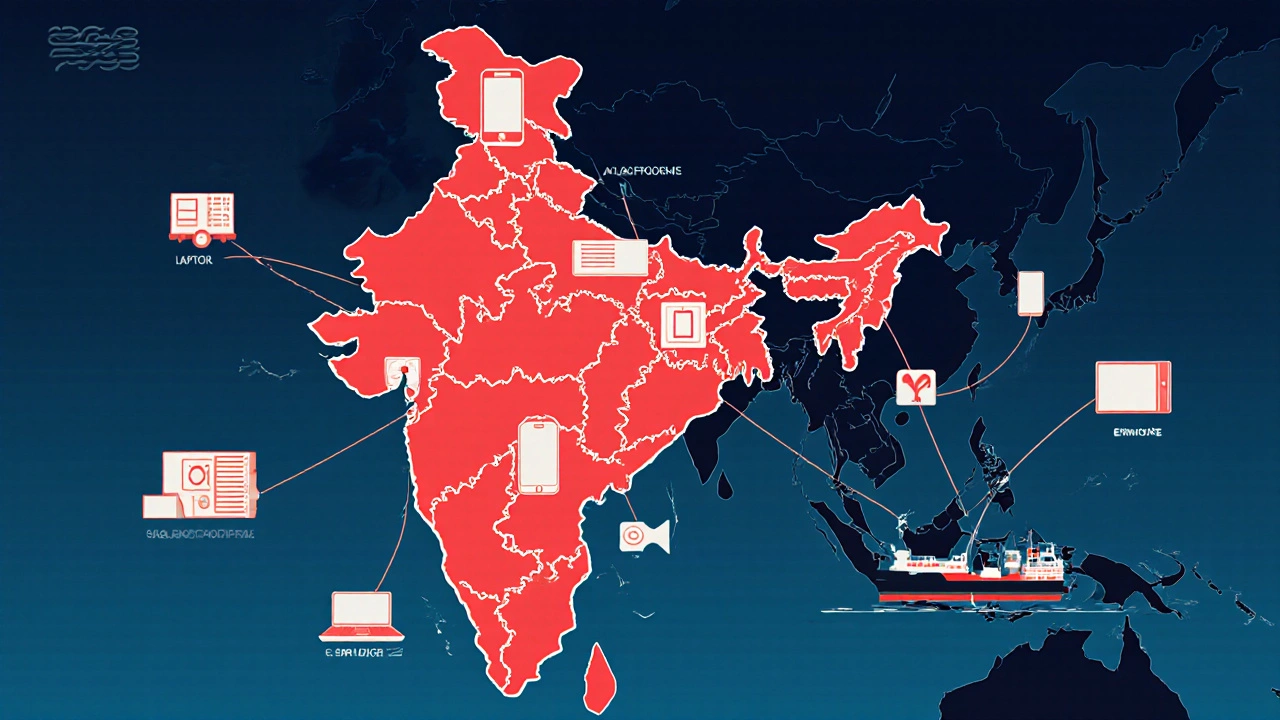State Electronics Export Calculator
Input Your Values
Results & Insights
Tamil Nadu's export share:
Compared to 2024 data: (Article shows 38% share)
Key Insight
Tamil Nadu currently holds 38% of India's electronics exports ($12B of $32B total).
For reference:
-
Karnataka: $5.2B
38% of Tamil Nadu's exports -
Maharashtra: $3.8B
32% of Tamil Nadu's exports -
Telangana: $2.9B
24% of Tamil Nadu's exports -
Andhra Pradesh: $2.1B
17.5% of Tamil Nadu's exports
When you think of India’s electronics boom, you might picture smartphones made in Bangalore or TVs assembled in Hyderabad. But the real story isn’t about where devices are built-it’s about where they’re shipped from. The state that leads India’s electronics exports isn’t the one with the most factories. It’s the one with the best mix of infrastructure, policy support, and global supply chain links.
Tamil Nadu is India’s top electronics exporter
In 2024, Tamil Nadu shipped over $12 billion worth of electronics abroad, according to data from the Directorate General of Foreign Trade (DGFT). That’s more than double what Karnataka, often seen as India’s tech hub, exported. Tamil Nadu’s lead isn’t new-it’s been consistent since 2018. What’s changed is the scale. The state now accounts for nearly 38% of India’s total electronics exports by value.
Why Tamil Nadu? It’s not just about Chennai. The real engine is the Sriperumbudur Industrial Corridor, just outside the city. This zone hosts Foxconn, Samsung’s largest smartphone plant outside Korea, and Dell’s biggest global manufacturing site. Together, these two alone export over 80 million smartphones and 5 million laptops annually. That’s not just production-it’s export-ready volume.
How Tamil Nadu beats the competition
Karnataka, home to Bengaluru’s startups and chip design firms, exports more high-value tech like semiconductors and embedded systems. But volume? That’s Tamil Nadu’s game. The state has a clear advantage: ports. Chennai Port is India’s second-busiest container port and handles over 60% of the country’s electronics shipments. Nearby Ennore Port adds another 15%. That means less time in transit, lower logistics costs, and faster turnaround for global buyers.
Other states struggle with this. Maharashtra has Mumbai’s port, but it’s congested. Telangana has Hyderabad’s tech parks, but lacks direct deep-sea access. Uttar Pradesh has cheap labor and big land, but poor rail and road links to ports. Tamil Nadu solved this with a 2015 policy called the Electronics and Hardware Manufacturing Policy. It offered 25% capital subsidy for export-oriented units and fast-tracked clearances. Companies didn’t just build factories-they built export pipelines.

The product mix: Phones, components, and beyond
Tamil Nadu doesn’t just export finished phones. Over 45% of its electronics exports are components: printed circuit boards, batteries, sensors, and connectors. That’s a big shift from five years ago, when exports were almost all assembled smartphones. Now, companies like Murata, TE Connectivity, and Flex have set up component plants in Hosur and Puducherry. These parts go into Apple, Xiaomi, and Samsung devices worldwide.
India’s total electronics exports hit $32 billion in 2024. Tamil Nadu’s $12 billion share means it’s responsible for nearly one-third of India’s entire tech export economy. The rest? Karnataka ($5.2B), Maharashtra ($3.8B), Telangana ($2.9B), and Andhra Pradesh ($2.1B). Even combined, those four don’t match Tamil Nadu’s output.
Why this matters for India’s economy
Electronics exports are no longer a side hustle for India. They’re a core part of the country’s trade balance. In 2020, India imported $60 billion in electronics. By 2024, imports dropped to $48 billion while exports jumped to $32 billion. That’s a $40 billion improvement in net trade position-and Tamil Nadu drove most of it.
For every $1 billion in electronics exports, the state creates about 12,000 direct jobs and another 8,000 in logistics, packaging, and support services. That’s 150,000 jobs tied to electronics exports in Tamil Nadu alone. Compare that to the 80,000 jobs created by software exports from Bengaluru. Electronics isn’t just about gadgets-it’s about manufacturing scale, skilled labor, and global integration.

What’s next for Tamil Nadu’s electronics sector
The state government is already planning the next phase. A new Electronics Manufacturing Cluster (EMC) is being built in Tirunelveli, focused on electric vehicle components and medical electronics. The idea is to move beyond consumer gadgets into industrial tech. Companies like Bosch and Siemens are already scouting locations.
Also, the PLI (Production Linked Incentive) scheme is working better here than anywhere else. Tamil Nadu has 23 approved PLI beneficiaries-more than any other state. These companies get cash incentives based on export growth. In 2024, PLI payouts to Tamil Nadu firms totaled ₹12,500 crore ($1.5 billion), mostly going to electronics exporters.
The real win? Exporters are now reinvesting profits locally. Samsung opened a new R&D center in Chennai in 2023 to design software for Indian markets. Foxconn is training 10,000 local engineers annually. This isn’t just assembly anymore-it’s innovation rooted in Tamil Nadu.
What other states can learn
Tamil Nadu’s success isn’t magic. It’s policy + port + patience. Other states tried copying the PLI scheme, but without ports or skilled labor pipelines, they couldn’t scale. Gujarat has good infrastructure but lacks electronics talent. Haryana has cheap land but no export ecosystem. The lesson is clear: you can’t export electronics if you can’t ship them.
For India to hit its $300 billion electronics export target by 2030, Tamil Nadu will need to keep leading. But it also needs help-better power supply, faster customs clearance, and more vocational training centers. The state is working on all three. If it succeeds, India won’t just be a maker of electronics. It’ll be a global exporter of them.
Is Tamil Nadu the only state exporting electronics from India?
No, Tamil Nadu is the largest exporter, but other states like Karnataka, Maharashtra, Telangana, and Andhra Pradesh also export electronics. Karnataka leads in high-value components and software-integrated devices, while Maharashtra exports through Mumbai’s port. However, none come close to Tamil Nadu’s total export volume.
What types of electronics does Tamil Nadu export the most?
Tamil Nadu exports mostly smartphones, laptops, and consumer electronics from factories like Samsung and Dell. But increasingly, it’s exporting critical components like printed circuit boards, batteries, sensors, and connectors. These parts are used in global devices made by Apple, Xiaomi, and others.
Why is Chennai important for electronics exports?
Chennai Port is India’s second-busiest container port and handles over 60% of the country’s electronics shipments. Its proximity to major manufacturing hubs like Sriperumbudur means faster loading, lower transport costs, and reliable delivery schedules. Ennore Port nearby adds extra capacity, making Chennai the most efficient export gateway for electronics.
How does the PLI scheme help Tamil Nadu’s electronics exports?
The Production Linked Incentive (PLI) scheme gives cash rewards to companies based on how much they export. Tamil Nadu has 23 approved PLI beneficiaries-the highest in India. In 2024, these firms received ₹12,500 crore ($1.5 billion) in incentives, which they reinvested into expanding production and hiring local talent. This directly boosted export volumes.
Will Tamil Nadu continue to lead in electronics exports?
Yes, unless other states dramatically improve their logistics and skill pipelines. Tamil Nadu has the ports, the policy support, the existing factories, and the trained workforce. New projects in Tirunelveli for EV components and medical electronics show it’s moving beyond smartphones. With ongoing investments and global demand, it’s likely to stay on top for at least the next five years.
